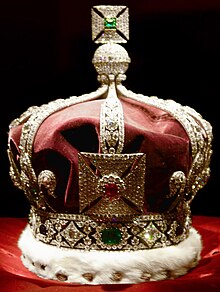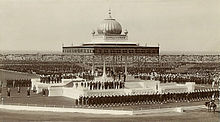Emperor of India
Kaiser or Kaiserin von India are translations of the title Emperor of India or Empress of India into German; British monarchs led him as rulers of British India .
Queen Victoria and the subsequent British kings were from 1876 to the independence of India and Pakistan in 1947 in personal union with Great Britain as the Emperor of India as the successor to the Mogul who was deposed from the British colonial administration in 1858 . B. by the inscription Imp. Ind. (Imperatrix Indiae or Imperator Indiae) or RI (Regina Imperatrix or Rex Imperator) was expressed on British coins. The Persian form Kaisar-i-Hind was also often used - Persian was the administrative language in the Mughal Empire .
In a figurative sense, however, the term is used (both in English and in German) for local emperors (the Mughals or as a translation of Samrat from Sanskrit).
history
Already in the course of the Sepoy uprising (1857) Bahadur Shah II. , The last Great Mughal of India, was proclaimed Emperor of India, but shortly afterwards he was deposed by the British.
On May 1, 1876, Victoria accepted the title of Empress of India under the Royal Titles Act - the proclamation took place in Delhi on January 1, 1877 - and thus documented that India had become part of the British Empire . The Empire of India included what is now India , Pakistan , Bangladesh, and Myanmar .
The title was introduced at the instigation of Prime Minister Benjamin Disraeli . As a result of the establishment of the German Empire and the position of the Russian tsars and the Austrian emperors , the British royal title should have equal rights. In addition, they wanted to give British rule (direct since 1857) a kind of legal basis by at least tying in with Mughal rule in terms of the title. The East India Company had formally ruled in the name of the Mughal emperor.
Only one of the British kings who held the title of Emperor of India was actually crowned emperor in India, namely George V on December 12, 1911 at the Delhi Durbar .
From the partition of India (1947) into two states - the secular Indian Union and the smaller Islamic Republic of Pakistan - until January 26, 1950, when India became a republic, the British monarch continued to be the head of state of the Indian Dominion . Until 1956, as King of Pakistan, he was also head of state of Pakistan, which became a republic in that year.
With the death of Elizabeth Bowes-Lyon in 2002, the last former Empress of India died.
List of emperors of India
Mughal Empire (1526-1858)
- Bahadur Shah II (May 1857 to September 1857)
British India (1858-1947)
- Victoria (May 1, 1876 / January 1, 1877 to January 22, 1901)
- Edward VII (January 22, 1901 to May 6, 1910)
- George V (May 6, 1910 to January 20, 1936)
- Edward VIII (January 20, 1936 to December 11, 1936)
- George VI. (December 11, 1936 to August 15, 1947)
Independent India as Dominion (1947–1950)
- George VI. (August 15, 1947 to January 26, 1950)
See also
- List of the Mughals (1526 to 1858)
- Governor General and Viceroy of India (with list; 1773 to 1950)
- List of Presidents of India (heads of state since 1950)
- List of Prime Ministers of India (heads of government since 1947)
- List of heads of state of Pakistan (heads of state since 1947)
- List of Prime Ministers of Pakistan (heads of government since 1947)



